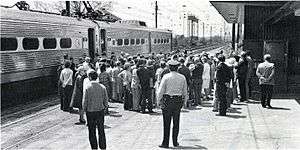Chesapeake (train)
|
Demonstration run of the Chesapeake on April 30, 1978, the day before regular service began | |||||
| Overview | |||||
|---|---|---|---|---|---|
| Service type | Inter-city rail | ||||
| Status | Discontinued | ||||
| Locale | Mid-Atlantic states | ||||
| First service | May 1, 1978 | ||||
| Last service | October 29, 1983 | ||||
| Successor |
SEPTA MARC Train | ||||
| Former operator(s) | Amtrak | ||||
| Route | |||||
| Start | Washington, DC | ||||
| End | Philadelphia | ||||
| Distance travelled | 134 miles (216 km) | ||||
| Average journey time | 2 hour 18 minutes | ||||
| Service frequency | Monday through Friday | ||||
| Train number(s) | 420, 421 | ||||
| On-board services | |||||
| Class(es) | Unreserved coach | ||||
| Technical | |||||
| Rolling stock | Arrow | ||||
| Track gauge | 4 ft 8 1⁄2 in (1,435 mm) | ||||
| Electrification | 11.5 kV 25 Hz AC Overhead catenary | ||||
| Track owner(s) | Amtrak | ||||
| |||||
The Chesapeake was a daily passenger train operated by Amtrak along the Northeast Corridor between Washington, D.C. and Philadelphia, Pennsylvania. It was one of the few commuter trains operated by Amtrak and operated from 1978 to 1983.
History
Service began on May 1, 1978, with funding from the Commonwealth of Pennsylvania and the State of Maryland; a demonstration trip ran from Philadelphia to Bowie on April 30.[1][2] BWI Rail Station was added to the service when it opened in October 1980.[3] From February 4, 1980 to October 25, 1981, the Chesapeake was extended from 30th Street to Suburban Station.[4]
The train primarily served higher-ranking business executives and government officials on the southbound trip in the morning, as it arrived too late for most civil servants. The northbound trip primarily served the latter group, as it departed too early to serve the morning riders for their return trip.[5]
On January 1, 1983, Conrail was relieved of its obligation to run commuter service. Commuter service in Pennsylvania was merged into SEPTA Regional Rail, and MDOT contracted with Amtrak to run other Washington-Baltimore commuter trips. The Chesapeake was discontinued on October 30, 1983; an unnamed Washington-Baltimore trip continued in its stead.[4] The SEPTA R2 (now the Wilmington/Newark Line) and MARC Penn Line operate commuter service over most of the Chesapeake, although no commuter service is run between Perryville and Newark.
Equipment
The Chesapeake operated with leased Arrow electric multiple units.[6]
Station stops
The following station stops were made by Chesapeake trains during the October 1980 to October 1981 period:
| State | City | Station | Notes |
|---|---|---|---|
| Pennsylvania | Philadelphia | Suburban Station | Now a Wilmington/Newark Line stop |
| 30th Street Station | Now an Amtrak and Wilmington/Newark Line stop | ||
| Chester | Chester Transportation Center | Now a Wilmington/Newark Line stop | |
| Delaware | Wilmington | French Street Station | Now an Amtrak and Wilmington/Newark Line stop |
| Newark | Newark Rail Station | Now an Amtrak and Wilmington/Newark Line stop | |
| Maryland | Elkton | Elkton | |
| Perryville | Perryville | Now a Penn Line stop | |
| Aberdeen | Aberdeen | Now a Penn Line and Amtrak stop | |
| Edgewood | Edgewood | Now a Penn Line stop | |
| Baltimore | Pennsylvania Station | Now a Penn Line and Amtrak stop | |
| Edmondson Avenue Station | Its replacement, West Baltimore station, is now a Penn Line stop | ||
| Linthicum | Baltimore Airport | Now a Penn Line and Amtrak stop | |
| Odenton | Odenton | Now a Penn Line stop | |
| Bowie | Bowie | Its 1989 replacement, Bowie State station, is now a Penn Line stop | |
| Lanham | Capital Beltway | Its 1983 replacement, New Carrollton station, is now an Amtrak and Penn Line stop | |
| Washington, D.C | Union Station | Now Penn Line and Amtrak stop | |
See also
- List of Amtrak routes#Northeast Corridor for other Amtrak trains named Chesapeake.
References
- ↑ Chesapeake Timetable; April 30, 1978 (Museum of Railway Timetables.org)
- ↑ Baer, Christopher T. (April 2015). "A GENERAL CHRONOLOGY OF THE SUCCESSORS OF THE PENNSYLVANIA RAILROAD COMPANY AND THEIR HISTORICAL CONTEXT: 1978" (PDF). Pennsylvania Railroad Technical and Historical Society.
- ↑ Chesapeake Timetable; October 26, 1980 (Museum of Railway Timetables.org)
- 1 2 Baer, Christopher T. (April 2015). "A GENERAL CHRONOLOGY OF THE SUCCESSORS OF THE PENNSYLVANIA RAILROAD COMPANY AND THEIR HISTORICAL CONTEXT: 1980-89" (PDF). Pennsylvania Railroad Technical and Historical Society.
- ↑ Meyer, Eugene L. (February 12, 1980). "A Commuter Train With a Split Personality: Commuter Train Shows A Changing Personality". Washington Post – via Proquest Historical Newspapers. (subscription required (help)).
- ↑ "Trivia Quiz". On Track. 1 (1): 15; 25. June 1981.
External links
- October 1, 1979 Amtrak Chesapeake Timetable (Railroad Picture Archives)
- Inaugural Run of Amtrak's Chesapeake (Window on Cecil County's Past)
